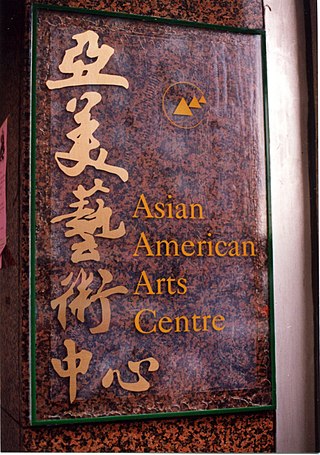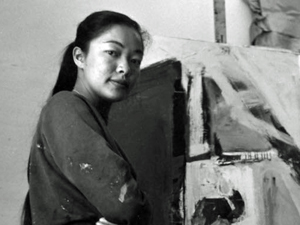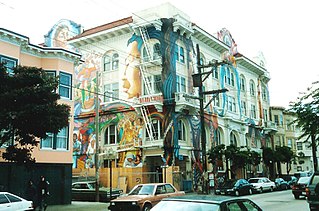Asian American Women Artists Association (AAWAA) is a nonprofit arts organization that supports and promotes the work of Asian American women artists in the visual, literary, and performing arts through activities such as art events, lectures, artists salons, and member exhibitions. [1]
Based in San Francisco, it was founded in 1989 by artists including Flo Oy Wong, Betty Kano, Moira Roth, and Bernice Bing. [1]
Kano and Wong were motivated to found the AAWAA after attending the 1989 national meeting of the Women's Caucus for Art, where they felt that Asian American women were heavily underrepresented, and by joining a project started by Moira Roth to create a collection of slides of artworks by women of color. [2] The first meeting was held at Kano's home in Berkeley in March of that year. [3]
In 2007, the organization formally incorporated as a 501(c)(3) non-profit. [3]
AAWAA's Speakers Bureau consists of artists, scholars, writers, and administrators who present at institutions regarding topics such as women's issues, Asian American issues, artists' process, and AAWAA programs. Members of the Speakers Bureau have lectured at numerous institutions in California.
Cynthia Tom (President), Shari Arai DeBoer (Secretary/Treasurer), Sigi Arnejo, Linda Inson Choy, Michelle Lee, Vinay Patel, and Pallavi Sharma.
Susan Almazol, Renee Baldocchi, Gracie Chidmat, Lori Chinn, Lydia Nakashima Degarrod, Natalie Gore, Nancy Hom, Anh-Hoa Thi Nguyen, Isabelle Thuy Pelaud, and Sue Tom.
Membership to the AAWAA is open to all, as either an artist member or an affiliate member. Notable members include Kathy Aoki, Bernice Bing, Lenore Chinn, Nancy Hom, Betty Kano, Dawn Nakanishi, Genny Lim, Isabelle Thuy-Pelaud, Canyon Sam, Valerie Soe, Flo Oy Wong, Wendy Yoshimura, and Katherine Westerhout.
Cheers to Muses is an anthology published by the AAWAA in 2007. The book compiles 77 works, including fine art, poetry, creative writing, and non-fiction work. The works are created by 64 Asian American women ranging in age from 14 to 85. [4]
Entering the Picture is a collection about contributions of feminists to American art. It is an interdisciplinary collection of essays by artists and scholars, many of whom were eyewitnesses to landmark events, relates how feminists produced vibrant bodies of art in Fresno and other locales where similar collaborations flourished. [5]
The Worlds of Bernice Bing is a documentary short film produced by the AAWAA, featuring the life and work of the lesbian Chinese American artist Bernice Bing. The film is directed by Madeleine Lim, executive artistic director of the Queer Women of Color Media Arts Project [6]
In 2013, the film received the Audience Award at the Queer Women of Color Film Festival.
Local Invisibility, Postcolonial Feminisms talks about studies in gender, sexuality, and culture. It looks into postcolonial poetic and artistic work of four generations of female Asian American artists in the San Francisco Bay Area. [7] There is a chapter on the AAWAA (Asian American Women Artists Association).
This program aims to stress an Asian American Women lens to curation, to promote Asian American Women in the arts, from a curating perspective and also benefits the artists who are under represented and lack exposure. [8]
In 2015, in honor of its 25th anniversary, the AAWAA launched a campaign to create a large collective mural in San Francisco's Richmond District. [9]
The mural is to honor the contributions of women artists in the Asian-American and Pacific Islander community. It is a response to the increased racial tensions and vandalism, and to increase the visibility of Asian American female artists. [10] "Mural Muses" will be one of the large-scale murals in the Bay Area to honor Asian-American artists.
Melanie Elvena, programs manager at the AAWAA stated that the collaborative mural was another way to raise awareness for Asian-American women artists "in a space that has been traditionally male dominated." [11]
A Place of Her Own (PLACE) is an art-based program, first created in 2008 by the AAWAA director Cynthia Tom. It is dedicated to improving women's mental health and seeks to challenge issues like colonization, racism, forced migration, and gender oppression. [12] It is based around the question in Virginia Woolf's A Room of One's Own: "If you had a place of your own, what would it be?" The weekly workshops over the course of six months lead up to a professionally curated exhibition. PLACE is open to all women, regardless of art ability of experience, and uses various art mediums.
PLACE offers down to earth healing tools, that relieve stress while opening up our ability to access and trust our intuition. The work is designed to help release underlying patterns and old habits and their links to individual, family and cultural histories and patterns of dysfunction. In order to thrive and take ownership of our life's path, women must define what is important to them alone, practicing self love and self-care. [13]
The AAWAA and the Asian Pacific Islander Cultural Center (APICC) presented this art exhibition as part of the United States of Asian America Festival [14] opening at SOMArts Cultural Center from May 4–25, 2017. Shifting Movements features 40 artists working in various mediums, mostly from Asian Pacific American, African-American, and Latin-American backgrounds. [15] The exhibition honors the Japanese-American activist Yuri Kochiyama. Shifting Movements also featured oral history recordings, a public installation created by the community, and the Smithsonian Asian Pacific American Center online exhibition Folk Hero: Remembering Yuri Kochiyama Through Grassroots Art.
underCurrents & the Quest for Space features the space occupied by Asian America - socially, artistically and physically. It is a multidisciplinary arts exhibition that addresses topics such as "model minority", and challenges faced by Asian American society such as stereotypes, discrimination and invisibility. [16] It is a joined force with Asian Pacific Islander Cultural Center (APICC).
Eating Cultures is a multi-disciplinary arts exhibition of artworks inspired by Asian American food and foodways. [17] Artists share stories of global fusion, and importance of food in Asian communities globally.
Hungry Ghosts exhibition uses the concept of "Hungry Ghosts", a common concept throughout many Asian cultures and religions, to explore the unsatisfied ghosts of the individual and collective historical struggles that continue to cast an effect the community. [18] It is co-presented by the Manilatown Heritage Foundation.
The exhibition took place on the 25th anniversary year of the AAWAA. It features the works of 38 AAWAA artists members, and highlights the diversity, creativity, and evolution of its artist community.
Agrarianaa: Art Inspired by APA Agricultural Roots is a multimedia exhibition featuring artists and farmers rooted in the history of Asian Pacific American agricultural crafts and legacies. The exhibition addresses topics including migrant labor, environmental activism, land and food sovereignty. It includes artists who talks about how a regenerative agricultural ecosystem can support into the resilient spaces for community. [19]

The San José Museum of Art (SJMA) is a modern and contemporary art museum in downtown San Jose, California, United States. Founded in 1969, the museum holds a permanent collection with an emphasis on West Coast artists of the 20th and 21st centuries. It is located at Circle of Palms Plaza, beside Plaza de César Chávez. A member of North American Reciprocal Museums, SJMA has received several awards from the American Alliance of Museums.
The Del Sol Quartet is a string quartet based in San Francisco, California that was founded in 1992 by violist Charlton Lee.
Lim Khim Katy is a contemporary Vietnamese artist. She is known for her paintings.
Nellie Wong is an American poet and activist for feminist and socialist causes. Wong is also an active member of the Freedom Socialist Party and Radical Women.

Kearny Street Workshop (KSW) in San Francisco, California, is the oldest multidisciplinary arts nonprofit addressing Asian Pacific American issues. The organization's mission is to produce and present art that enriches and empowers Asian Pacific American communities. Notable participants include author and Asian American studies scholar Russell Leong, playwright and author Jessica Hagedorn, author Janice Mirikitani, poet and historian Al Robles, and actor and filmmaker Lane Nishikawa.
The history of art in the San Francisco Bay Area includes major contributions to contemporary art, including Abstract Expressionism. The area is known for its cross-disciplinary artists like Bruce Conner, Bruce Nauman, and Peter Voulkos as well as a large number of non-profit alternative art spaces. San Francisco Bay Area Visual Arts has undergone many permutations paralleling innovation and hybridity in literature and theater.

The Asian American Arts Centre (AAAC) is a non-profit organization located in the Chinatown neighborhood of Manhattan in New York City. Founded in 1974, it's one of the earliest Asian American community organizations in the United States. The Arts Centre presents the ongoing developments between contemporary Asian & Asian American art forms and Western art forms through the presentation of performance, exhibitions, and public education. AAAC's permanent collection, which it has accumulated since 1989, contains hundreds of contemporary Asian American art works and traditional/folk art pieces. The organization also has an Artists Archive which documents, preserves, and promotes the presence of Asian American visual culture in the United States since 1945. This includes the East Coast, especially the greater New York area; the West Coast; and some artists in Canada, Hawaii, and overseas. The artists include Asian Americans producing art, Asian artists who are active in the United States, and other Americans who are significantly influenced by Asia. Pan-Asian in outlook, the Arts Centre's understanding of 'Asia' encompasses traditions and influences with sources ranging from Afghanistan to Hawaii.
Godzilla: Asian American Arts Network was a New York-based Asian American arts collective and support network established in 1990. Founding members Ken Chu, Bing Lee, Margo Machida, and others established Godzilla in order to facilitate inter-generational and interdisciplinary dialogue and collaboration for Asian American artists and art professionals. The collective provided visibility in local and national exhibitions, developed press outreach strategies, published newsletters, and sponsored symposia on Asian American art. It was disbanded in 2001.
Lenore Chinn is an American artist best known for her American realist paintings and her queer activism. Chinn was a founding member of Lesbians in the Visual Arts and Queer Cultural Center (QCC) and served on the San Francisco Human Rights Commission. She is currently based in San Francisco, California.

Bernice Bing was a Chinese American lesbian artist involved in the San Francisco Bay Area art scene in the 1960s. She was known for her interest in the Beats and Zen Buddhism, and for the "calligraphy-inspired abstraction" in her paintings, which she adopted after studying with Saburo Hasegawa.

Miranda Bergman is an American contemporary muralist born in 1947 and grew up in grew up in the San Francisco Mission District where she attended Balboa High School. Bergman is known for of the seven women artists who in 1994 created the MaestraPeace mural, the largest mural in San Francisco, which covers The Women's Building. Most of the murals created/co-created by Bergman straddles artistry and social activism, giving her a space to express both social struggles and cultural celebrations. She now lives in Oakland.
Terry Acebo Davis is a Filipino American artist and nurse based in the San Francisco Bay Area. Her art is thematically linked to her family and her origins as a Filipino American.
Flo Oy Wong is an American artist, curator, and educator, of Chinese-descent. She had co-founded the Asian American Women Artists Association (AAWAA) in San Francisco.
Madeleine Lim is a filmmaker, producer, director, cinematographer and LGBTQ activist. She is the founding Executive Director of the Queer Women of Color Media Arts Project (QWOCMAP), and an adjunct professor of film studies at the University of San Francisco. Lim is also a co-founder of SAMBAL and the US Asian Lesbian Network in the San Francisco Bay Area.
Margo Machida is an American art historian, curator, cultural critic, and artist.
Art is a popular form of expression within the Asian American community and can be seen as a way for the community to push against tradition. Common forms of art are painting or photography and the first known record or Asian American art was in 1854, in the form of a photography studio by Ka Chau entitled "Daguerrean Establishment". Performance art became a popular form of expression by the 1960s, allowing artists like Linda Nishio to focus on issues of representation and self-image. Music is also used as a form of expression within the Asian American community.
Cindy Shih is a Taiwanese-born American visual artist. Her work is strongly rooted in traditional techniques and principles, including Chinese literati painting, Venetian plasterwork, landscape painting, and realism, although producing thoroughly modern pieces. One of her prominent themes is exploring her personal narrative in a broad context. She lives in San Francisco, California.

Amanda Phingbodhipakkiya is a multidisciplinary artist and speaker based in Brooklyn, New York. She is behind the project I Still Believe in Our City and Beyond Curie. Phingbodhipakkiya is a neuroscientist-turned-artist and an advocate of STEM who is known for conveying complex scientific ideas via art. As an artist, Phingbodhipakkiya works with murals, textiles, sculptures, public art campaigns and participatory installations and her art often touches on themes of AAPI, women, STEM, and human rights issues.

Solomon Enos is a Native Hawaiian artist, illustrator, and activist. Enos has had their work displayed at the National Museum of the American Indian and Bernice Pauahi Bishop Museum.

Nancy Hom is a Chinese-born American visual artist, illustrator, curator, writer, and arts administrator. She served as the executive director of Kearny Street Workshop for many years. Hom lives in San Francisco, California.